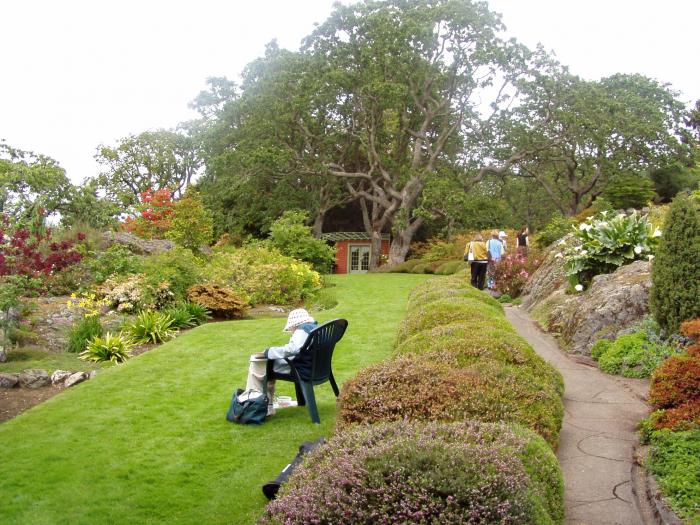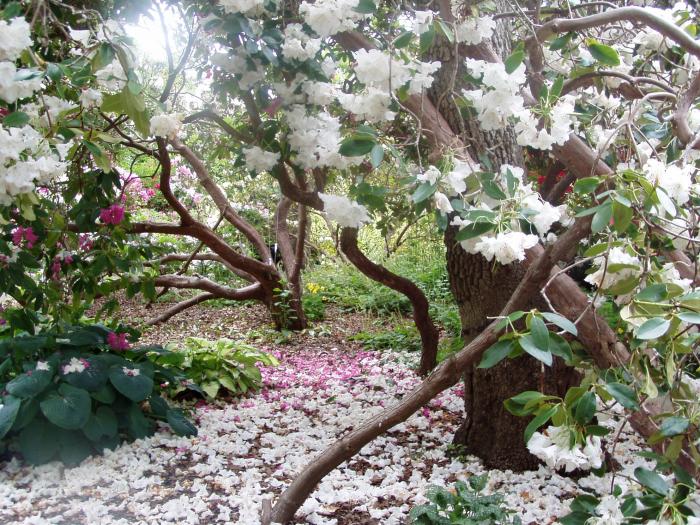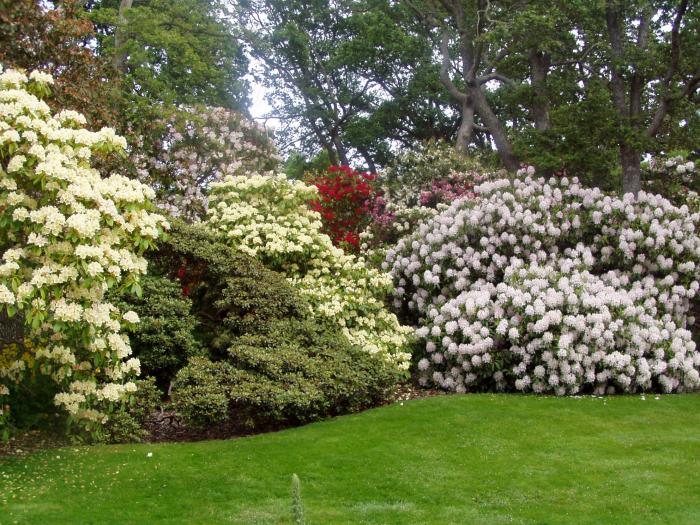 The natural character of the landscape – what is inherent in the site, not what has been imposed on it - is the defining characteristic of the garden. The glaciated rock outcroppings and the mature Garry oak trees show a strong sense of local distinctiveness that make the property unique to the southern tip of Vancouver Island.
The natural character of the landscape – what is inherent in the site, not what has been imposed on it - is the defining characteristic of the garden. The glaciated rock outcroppings and the mature Garry oak trees show a strong sense of local distinctiveness that make the property unique to the southern tip of Vancouver Island.
Peggy Pemberton Carter recognized the strength of the site when she bought the property in 1946. Others saw the limitations of the property, which was why it was one of the last undeveloped lots in the Fairfield neighbourhood, but Peggy saw the possibilities.
One of the first things Peggy did after purchasing the property was to hire an architect, John Wade, to design her summerhouse. John Wade was a young professional who had worked in the offices of the brilliant modernist architect Richard Neutra in Los Angeles. Neutra had a strong sense of the flow between interior design and the exterior landscape which became a hallmark of the California West Coast Style. The California landscape architects of the time also were expressing new ideas about landscape design. They felt that a garden could be “more than a collection of plants, more than an imitation of historical styles and that it could be, once again, an art form, expressive of its place, time and people.” Ideas such as these were new and had a strong influence on the young John Wade and can be seen in his work at the Abkhazi Garden. Peggy records that by November 1946 the summerhouse was built and the paths were laid. John Wade designed all the structures on the property, including the very organic flowing lines of the terraces. We believe that his influence is to be felt in the laying out of the paths of the garden as well.
 Peggy Pemberton Carter probably needed little convincing about the soundness of these new ideas. They embraced much of the aesthetic that she was familiar with in the gardens near her former home in Shanghai. Chinese gardens are essentially places of meditation, places to withdraw from worldly cares. This must have been very appealing for both Peggy and Nicholas Abkhazi after their experiences in prisoner of war camps during World War II. Nothing in a Chinese garden is hurried or blatant. Paths are not just a direct means of access from one point to another, instead they are a way of exploring changing views that slowly shift as the visitor journeys through the garden. Landscape painting in China has close links with gardens. The experience of wandering in the garden was likened to unrolling a long scroll of a Chinese landscape painter. Peggy referred to this analogy herself.
Peggy Pemberton Carter probably needed little convincing about the soundness of these new ideas. They embraced much of the aesthetic that she was familiar with in the gardens near her former home in Shanghai. Chinese gardens are essentially places of meditation, places to withdraw from worldly cares. This must have been very appealing for both Peggy and Nicholas Abkhazi after their experiences in prisoner of war camps during World War II. Nothing in a Chinese garden is hurried or blatant. Paths are not just a direct means of access from one point to another, instead they are a way of exploring changing views that slowly shift as the visitor journeys through the garden. Landscape painting in China has close links with gardens. The experience of wandering in the garden was likened to unrolling a long scroll of a Chinese landscape painter. Peggy referred to this analogy herself.
Abkhazi Garden is not a Californian garden or a Chinese garden, but both of these influences came together to play a part in this truly unique and modern creation.
The Abkhazi Garden is a dynamic work of art. There is a clear decisiveness of intention in the garden layout. The site itself imposes a discipline and there is a unity of execution in the layout of buildings, paths and choice of plant material. Forms and materials were selected to express one over ruling idea, the rhythm of the natural landscape. All the buildings on the property – house, summerhouse and garden – are modest in size and construction and appropriate in scale and material to the landscape. The paths are intimate and show a human scale appropriate for the private world the Abkhazis wanted to create for themselves.
 The Garry oaks are the predominant plant on the site. They provide a sense of stability and serenity. They are strong sculpturally and unify all parts of the garden. Other significant plants on the property are especially notable for their maturity and precise placing. Some rhododendrons are over 100 years old; their gnarled trunks are as attractive as their flowers. Mature conifers are trained to cascade down the rock faces and mature specimens of azaleas have been pruned carefully over decades to be living sculptures today. Naturalized bulbs carpet the garden in sheets of colour at different seasons of the year. Choice alpine plants are sited carefully in naturally formed rock crevices
The Garry oaks are the predominant plant on the site. They provide a sense of stability and serenity. They are strong sculpturally and unify all parts of the garden. Other significant plants on the property are especially notable for their maturity and precise placing. Some rhododendrons are over 100 years old; their gnarled trunks are as attractive as their flowers. Mature conifers are trained to cascade down the rock faces and mature specimens of azaleas have been pruned carefully over decades to be living sculptures today. Naturalized bulbs carpet the garden in sheets of colour at different seasons of the year. Choice alpine plants are sited carefully in naturally formed rock crevices
This garden is more than the sum of its plants. Changes were made to the garden by the Abkhazis in their lifetime as their tastes changed. Many plants have been lost over the years, as happens in all gardens. New plants are being added, some have historical precedence and others are new to the trade and the garden. The Abkhazis were always interested in new plants and had as their mentors many of the best nurserymen of their day. The plants were chosen to enhance the natural landscape not detract from it. The Abkhazis did not do summer bedding, but relied on good foliage and texture to see them through months when the main flush of colour was over. The plants that have thrived over the last fifty years are the plants that have proven to be best adapted to the site. This evolution to a more drought tolerant planting is an ongoing process.
 The garden is significant because the same two people cared for it and maintained it over forty years. The same two pairs of eyes watched and managed its development, pruned and shaped its trees with a constant and shared vision which they lived to see come to maturity. In our mobile society this is a rare occurrence.
The garden is significant because the same two people cared for it and maintained it over forty years. The same two pairs of eyes watched and managed its development, pruned and shaped its trees with a constant and shared vision which they lived to see come to maturity. In our mobile society this is a rare occurrence.
Every garden has a story. The personal story of the Abkhazis, with its tragedy, romance and reunion is more dramatic and colourful than most. It is well documented and gives another level of interest and significance to the garden. Their separate lives were directly affected by some of the major historical events of the last century. Peggy and Nicholas were both very private people, yet from as early as 1949 they welcomed groups of visitors to enjoy the beautiful garden they had created. The Abkhazis were cultured people who came to Victoria because Peggy was told that in Victoria one could be left to be as eccentric as one wanted to be. They pursued their eccentric lives here and left a very unique garden legacy that has now been preserved for our enjoyment and our education.
No visit to Abkhazi Garden is complete without a stop in the tearoom, the former living room of Peggy and Nicholas Abkhazi. Enjoy one of Peggy’s favourite lunches — an open-faced sandwich of dark rye bread, spread with cream cheese and topped with slices of smoked salmon, also served with a small salad of organic greens and flowers with a light citrus dressing. Try the excellent plowman’s lunch with local cheddar and camembert, a dense, flavourful pork terrine, freshly made chutney and assorted breads along with a cup of soup. Sip your tea and nibble on lemon loaf, chocolate truffles and fresh fruit to finish as you overlook the gardens love created.
Abkhazi Garden
1964 Fairfield Rd.
Victoria, BC
Telephone: (250) 598-8096



